Invigorated Liverpool triumph in game of two halves
Following a prolonged period of mediocre form, including a defeat to Leicester City on Monday night, Klopp’s Liverpool returned to Anfield to face an Arsenal side who have been on an equally poor run, losing their last three Premier League games. Arsenal were one point ahead of Liverpool with a game in hand going into this match, meaning a win was crucial for Klopp’s side to keep their top 4 hopes alive. Bewilderment was created amongst the Arsenal faithful pre-match due to Wenger’s decision to drop Alexis Sánchez, with Olivier Giroud starting in his place. The hosts were still without captain Jordan Henderson and Dejan Lovren due to injury, whilst Ragnar Klavan replaced Lucas at centre back.
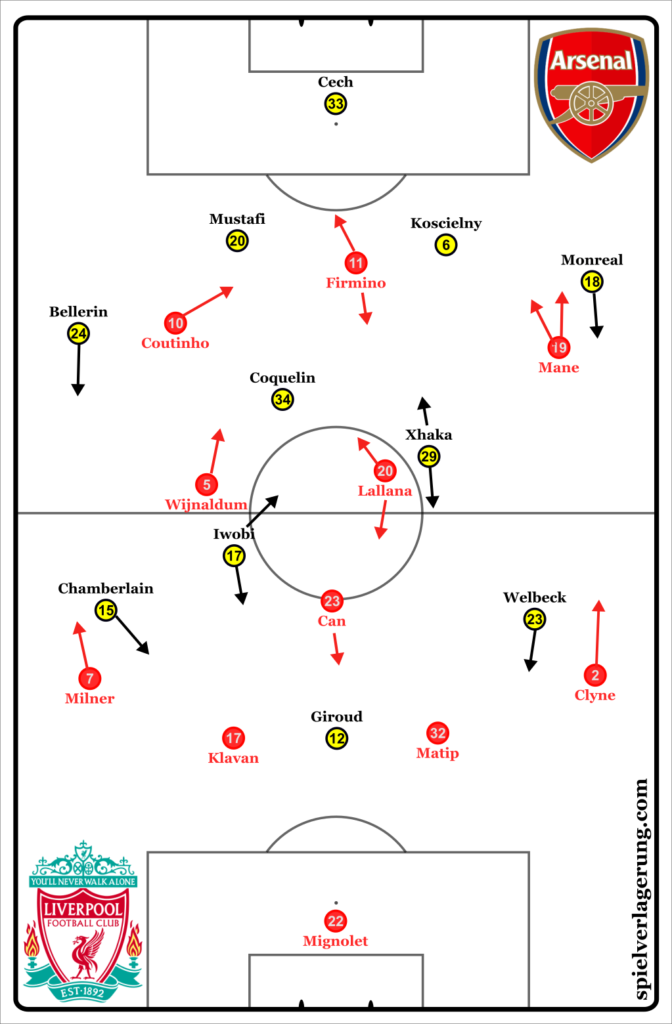 Liverpool’s commanding first half
Liverpool’s commanding first half
Despite the heading, Arsenal started the game in a decisive manner that demonstrated signs of the direct, counter-attacking style of play Wenger intended to play. Immediately after Liverpool kicking-off, Arsenal fell into a deep 4-1-4-1 block that was horizontally and vertically compact, with barely 5 metres between the defensive and midfield lines. This limited space centrally for Liverpool, forcing their build-up wide, where Arsenal’s zonal block shifted horizontally in orientation to the ball. Arsenal were able to regain possession initially, such as in the third minute, where Liverpool attempted to access limited gaps in their compact central structure. This led to Arsenal outnumbering Liverpool on the counter, with Wijnaldum and Lallana being caught up-field in defensive transition after roaming through Arsenal’s defensive structure. When in possession in the final third, Arsenal predominantly found space in the wide channels due to Liverpool’s fairly narrow structure. On two separate occasions when Xhaka had the ball in the centre, Oxlade-Chamberlain and Monreal entered the space outside and behind Liverpool’s full backs, though the attempted passes from Xhaka were uncompleted.
So there were signs that Wenger’s approach may reap rewards, however that all changed after the 7th minute following Firmino’s opening goal. From this point, the home side dominated the remainder of the first half.
Koscielny’s missed header and orientation towards the flight of Mignolet’s goal kick, dragging him forwards and out of position, left a 3 v 3 situation for Liverpool. This forced Monreal to move centrally to fill the void left by Koscielny, leaving Mane open on the right wing to play the cross to Firmino, who also found himself open on the other side of the box due to Arsenal’s defenders being occupied by Lallana and Coutinho in the centre
It was a similar story in the build-up to Liverpool’s second. Lallana’s central diagnoal run manipulated Monreal as part of Arsenal’s compact arrangement, forcing him to follow and occupy Lallana in a central position, leaving Mane wide open on the right-hand side of the penalty area to double the home side’s lead.
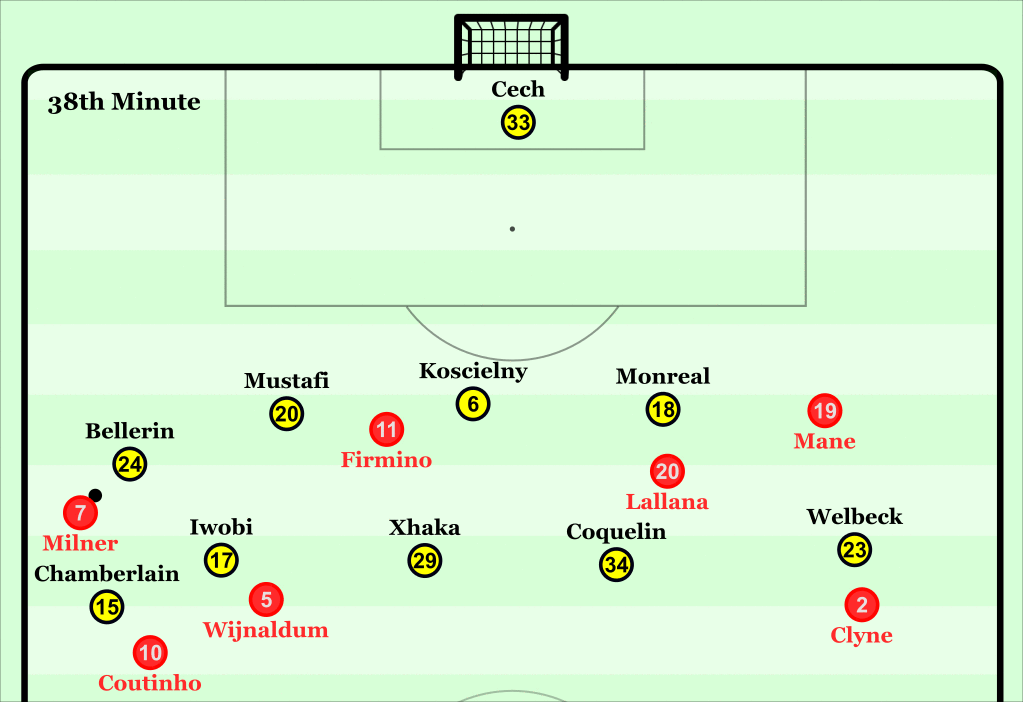
Wijnaldum’s off ball movement through Iwobi’s blindside and Lallana’s occupation of Monreal were key elements of the build-up to Liverpool’s second goal
Arsenal couldn’t deal with Liverpool’s intensity in all four phases of the game. When the home side were in deep build-up play, Arsenal would attempt to press Liverpool by either Xhaka or Iwobi stepping out of their deep 4-5-1 structure to help Giroud put pressure on Liverpool’s first line of play. However, Emre Can frequently dropped to create a three-man back line with Matip and Klavan, meaning that Liverpool repeatedly bypassed this pressure by circulating the ball through their numerical superiority in these situations of 3 v 2. Arsenal struggled to win the ball high up the pitch all match.
This momentary 4-4-2 created by Xhaka and Iwobi’s forward pressing movements left central gaps and passing lanes between Arsenal’s midfielders, stretching Arsenal vertically and horizontally. This allowed Liverpool’s midfielders, especially Lallana and Coutinho to access dangerous spaces between the lines of Arsenal’s midfield and defence.
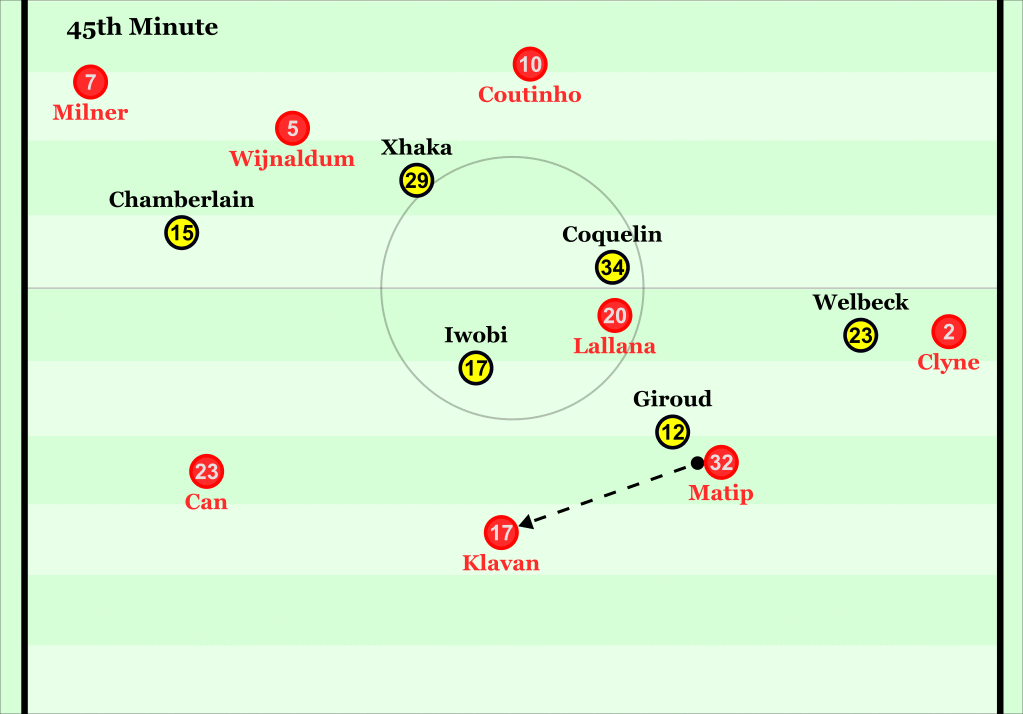
Arsenal’s pressing structure allowed Liverpool’s midfielders to access key central areas. Lallana’s occupation of Coquelin in this scenario is key in releasing space for Coutinho.
Liverpool’s defensive structure and pressing was considerably more effective than the away side. They adopted a fluid defensive structure on the occasions that Arsenal had the ball inside their half that varied between a compact 4-5-1, 4-3-3 and 4-2-3-1, which limited Arsenal’s options to progress through the centre significantly. The fluid nature of the hosts’ pressing shape allowed players such as Lallana to step out of the midfield line and press Arsenal’s central midfielders, whilst the other Liverpool midfielders would fill in behind and remain compact to leave Arsenal no central passing options to progress possession. The timing of these pressing actions by Lallana in particular was exceptional. He started his pressing movements at exactly the right moment, whether that was in anticipation of a loose first touch or if an Arsenal player had his back turned to him, and he could close them down through their cover shadow. Francis Coquelin was particularly vulnerable under these circumstances, who showed poor anticipation, intelligence and technical ability to evade the pressing intensity. This occasionally led to Liverpool regaining possession in areas that presented opportunities to run at Arsenal’s defence and develop promising counter attacks, but they failed to extend their lead further by wasting these situations. This was predominantly through poor final pass choices and off ball movements that weren’t complementary in relation to one another and the ball carrier.
Arsenal were reluctant to play out from the back the whole match. Čech heaved goal kicks forward into the midfield time and time again, where Liverpool were increasingly able to win possession due to their effective structure surrounding the ball, giving them good access. This allowed them to win an abundance more loose balls than Arsenal. After claiming possession, the forward momentum of Liverpool’s midfield runners compared to Arsenal’s retreating midfielders allowed them to access the space behind their midfield between the lines. This was because of their superior running dynamic compared to Arsenal’s players who had to turn and face their own goal before running. Therefore the red shirts were already beyond them by the time they turned. This was a common occurrence due to the visitor’s recurring directness from goal kicks.
Furthermore, the horizontal compactness that served Arsenal well in the very early stages of the match evolved to become a vulnerability. Their structure became relatively central and lost it’s ball orientation, meaning their positioning was immobile and passive. This left the wide channels easily accessible for Liverpool, and they were able to progress possession via these areas with relative ease. The development of this space on the wing was also aided by Liverpool players making diagonal runs off the ball.This was especially the case down the left flank, where Coutinho, Lallana, and Wijnaldum’s movement in particular dragged Arsenal defenders away from the flank, giving Milner time and space.
Arsenal’s half time refresh
Wenger’s approach in the first half had evidently backfired, which led to Alexis Sánchez being subbed on for Francis Coquelin at half time. This saw Arsenal move to their more familiar 4-2-3-1 base. Oxlade-Chamberlain formed a double pivot with Xhaka, whilst Sanchez was positioned on the left wing due to Giroud’s presence up front.
Arsenal began to find more space in and around Liverpool’s midfield, and enjoyed a greater percentage of possession compared to their hosts following the break, contrary to the first half. They primarily found space on the left wing. Mane’s half-space and central orientation when Liverpool had possession meant he was often too far away from Sanchez and Monreal once Arsenal won the ball back, and he was consequently unable to cover their runs down the wing. Additionally, Liverpool’s central midfielders were sometimes over-active, meaning they drifted out of a stable defensive position at times, and Arsenal used their ball circulation from right to left in particular to exploit this.
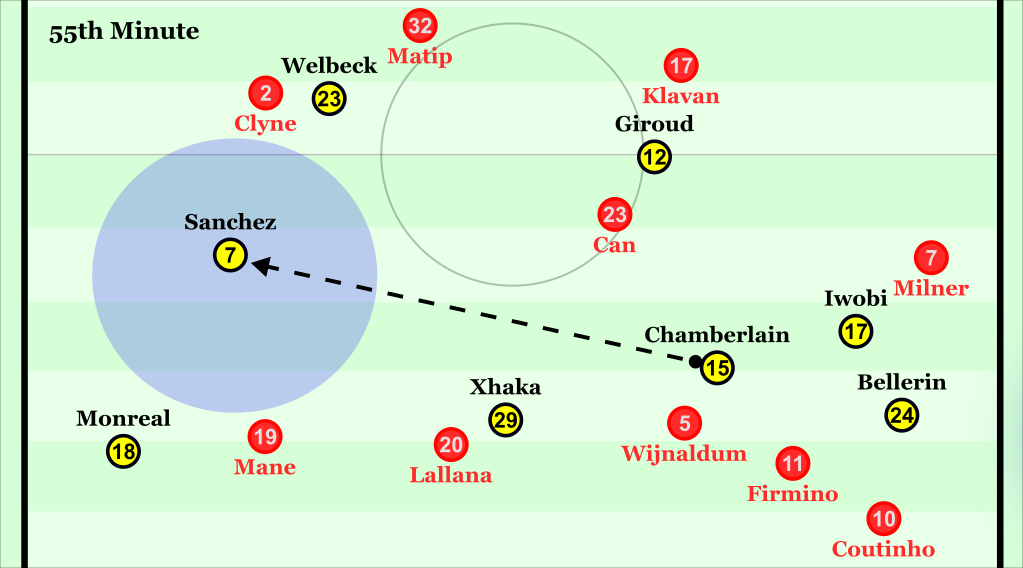
Sanchez was repeatedly able to find space on the left wing and half-space following his introduction at half time
This shifting from right to left resulted in two quality chances for Arsenal. One in the 47th minute where Monreal had space on the wing to deliver a cross to Giroud, whose header produced an excellent Mignolet save. The other was in the 56th minute, which resulted in Welbeck’s goal. Mane was caught too far forward, which left Sanchez unmarked with space to advance and to deliver a defence splitting pass through to Welbeck.
Nevertheless, despite the improvements they showed after the interval, these were the only clear cut chances Arsenal generated all match. Liverpool often found little space in the centre to combine and penetrate into The Gunners’ penalty area, but they were largely able to retain control of proceedings following Arsenal’s goal. Despite some late pressure, a wonderful Liverpool counter attack in the 91st minute ended with Wijnaldum scoring a third to secure all three points for Klopp’s side, temporarily moving them up to 3rd in the league table.
Conclusion
The result of this match didn’t come as a surprise. Liverpool extended their exceptional record against the Premier League’s top 6 this season, whilst Arsenal on the whole looked disorganised and lost, especially in the first half. This has been an increasingly common occurrence in recent times under Arsène Wenger. Klopp’s side were much more dynamic and intense than Arsenal, whose set-up to be direct and counter attack actually left them vulnerable to Liverpool in defensive transition. The decision by Wenger to leave Arsenal’s best player, Alexis Sánchez, on the bench remains a puzzling one. Although subsequently after the match, rumours of a training ground bust-up involving Sánchez arose. Wenger denied this speculation, but the Chilean’s future in North London is becoming increasingly uncertain.
Arsenal are in unfamiliar territory. They are in a period of poor form, where tactical, technical and mental issues hang over the club. They continue to drop points compared to their rivals, and it’s looking increasingly likely that they will finish outside of the top four come the end of the season. The dominant view is that Wenger needs to leave the club in order to fix their issues, but whether that will happen in the near future or not remains to be seen.


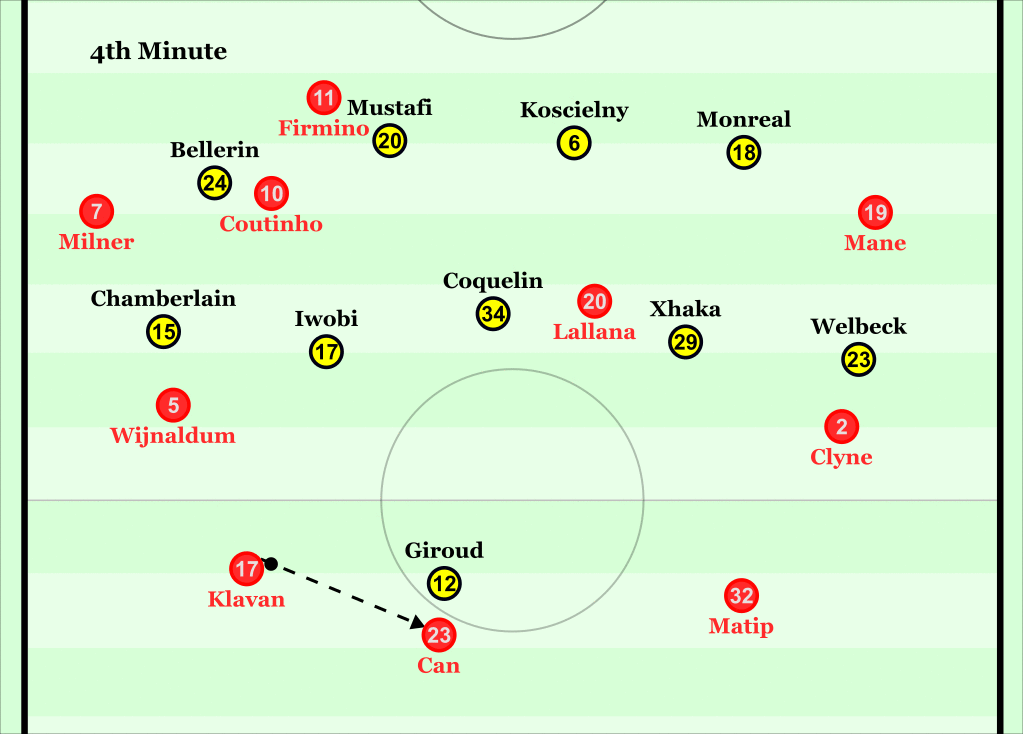
1 Kommentar Alle anzeigen
Marcos March 10, 2017 um 3:58 pm
Great article. But why Liverpool can’t do this kind of work against small clubs? Their press works well only against the big ones.